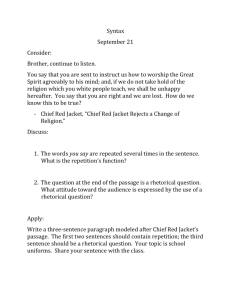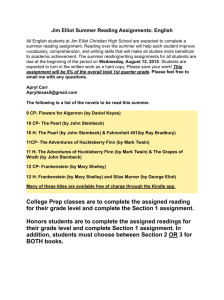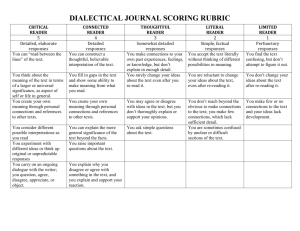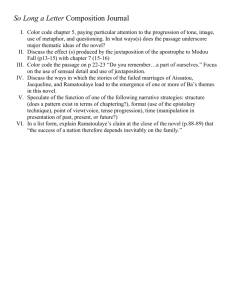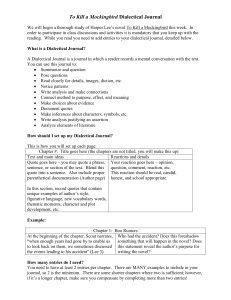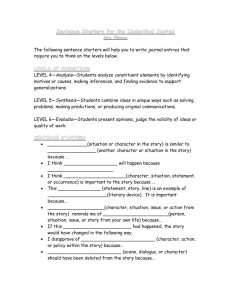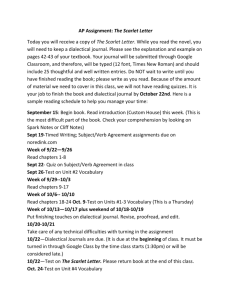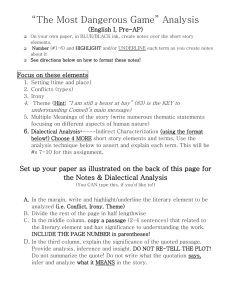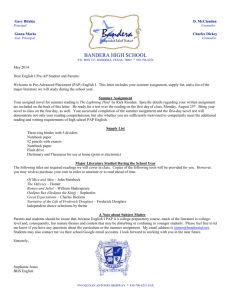AP Lit Assignment - Fulton County Schools
advertisement
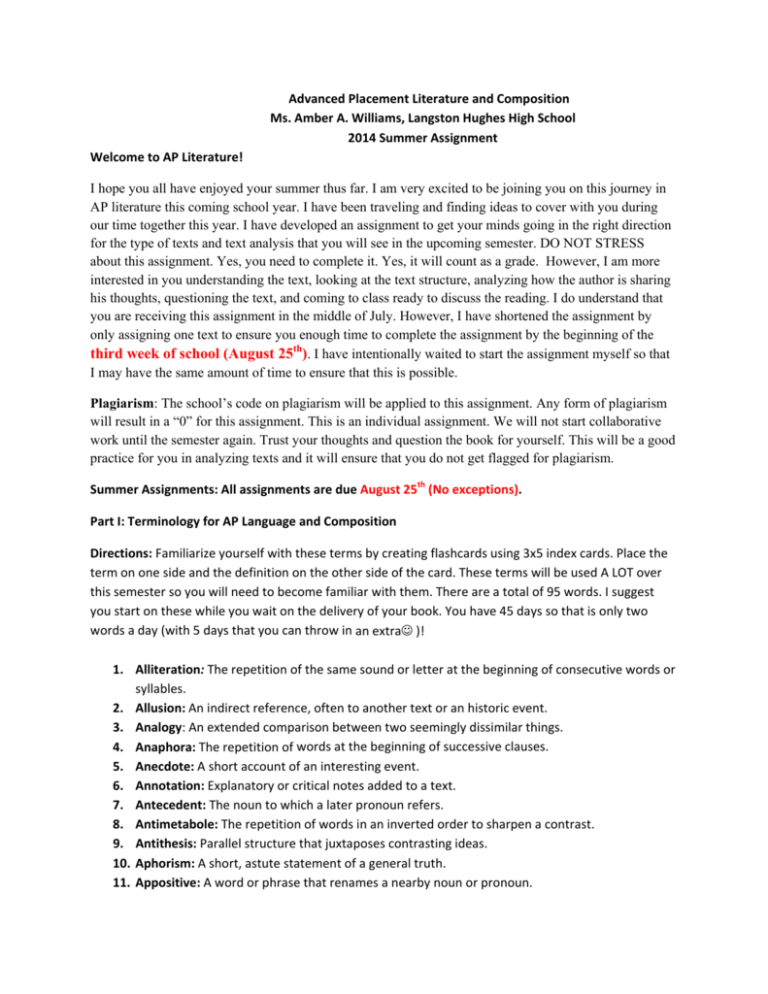
Advanced Placement Literature and Composition Ms. Amber A. Williams, Langston Hughes High School 2014 Summer Assignment Welcome to AP Literature! I hope you all have enjoyed your summer thus far. I am very excited to be joining you on this journey in AP literature this coming school year. I have been traveling and finding ideas to cover with you during our time together this year. I have developed an assignment to get your minds going in the right direction for the type of texts and text analysis that you will see in the upcoming semester. DO NOT STRESS about this assignment. Yes, you need to complete it. Yes, it will count as a grade. However, I am more interested in you understanding the text, looking at the text structure, analyzing how the author is sharing his thoughts, questioning the text, and coming to class ready to discuss the reading. I do understand that you are receiving this assignment in the middle of July. However, I have shortened the assignment by only assigning one text to ensure you enough time to complete the assignment by the beginning of the third week of school (August 25th). I have intentionally waited to start the assignment myself so that I may have the same amount of time to ensure that this is possible. Plagiarism: The school’s code on plagiarism will be applied to this assignment. Any form of plagiarism will result in a “0” for this assignment. This is an individual assignment. We will not start collaborative work until the semester again. Trust your thoughts and question the book for yourself. This will be a good practice for you in analyzing texts and it will ensure that you do not get flagged for plagiarism. Summer Assignments: All assignments are due August 25th (No exceptions). Part I: Terminology for AP Language and Composition Directions: Familiarize yourself with these terms by creating flashcards using 3x5 index cards. Place the term on one side and the definition on the other side of the card. These terms will be used A LOT over this semester so you will need to become familiar with them. There are a total of 95 words. I suggest you start on these while you wait on the delivery of your book. You have 45 days so that is only two words a day (with 5 days that you can throw in an extra )! 1. Alliteration: The repetition of the same sound or letter at the beginning of consecutive words or syllables. 2. Allusion: An indirect reference, often to another text or an historic event. 3. Analogy: An extended comparison between two seemingly dissimilar things. 4. Anaphora: The repetition of words at the beginning of successive clauses. 5. Anecdote: A short account of an interesting event. 6. Annotation: Explanatory or critical notes added to a text. 7. Antecedent: The noun to which a later pronoun refers. 8. Antimetabole: The repetition of words in an inverted order to sharpen a contrast. 9. Antithesis: Parallel structure that juxtaposes contrasting ideas. 10. Aphorism: A short, astute statement of a general truth. 11. Appositive: A word or phrase that renames a nearby noun or pronoun. 12. Archaic diction: The use of words common to an earlier time period; antiquated language. 13. Argument: A statement put forth and supported by evidence. 14. Aristotelian triangle: A diagram that represents a rhetorical situation as the relationship among the speaker, the subject, and the audience (see rhetorical triangle). 15. Assertion: An emphatic statement; declaration. An assertion supported by evidence becomes an argument. 16. Assumption: A belief or statement taken for granted without proof. 17. Asyndeton: Leaving out conjunctions between words, phrases, clauses. 18. Attitude: The speaker’s position on a subject as revealed through his or her tone. 19. Audience: One’s listener or readership; those to whom a speech or piece of writing is addressed. 20. Authority: A reliable, respected source—someone with knowledge. 21. Bias: Prejudice or predisposition toward one side of a subject or issue. 22. Cite: Identifying a part of a piece of writing as being derived from a source. 23. Claim: An assertion, usually supported by evidence. 24. Close reading: A careful reading that is attentive to organization, figurative language, sentence structure, vocabulary, and other literary and structural elements of a text. 25. Colloquial/ism: An informal or conversational use of language. 26. Common ground: Shared beliefs, values, or positions. 27. Complex sentence: A sentence that includes one independent clause and at least one dependent clause. 28. Concession: A reluctant acknowledgment or yielding. 29. Connotation: That which is implied by a word, as opposed to the word’s literal meaning (see denotation). 30. Context: Words, events, or circumstances that help determine meaning. 31. Coordination: Grammatical equivalence between parts of a sentence, often through a coordinating conjunction such as and, or but. 32. Counterargument: A challenge to a position; an opposing argument. 33. Cumulative sentence An independent clause followed by subordinate clauses or phrases that supply additional detail. 34. Declarative sentence: A sentence that makes a statement. 35. Deduction: Reasoning from general to specific. 36. Denotation: The literal meaning of a word; its dictionary definition. 37. Diction: Word choice. 38. Documentation: Bibliographic information about the sources used in a piece of writing. 39. Elegiac: Mournful over what has passed or been lost; often used to describe tone. 40. Epigram: A brief witty statement. 41. Ethos: A Greek term referring to the character of a person; one of Aristotle’s three rhetorical appeals (see logos and pathos). 42. Figurative language: The use of tropes or figures of speech; going beyond literal meaning to achieve literary effect. 43. Figure of speech: An expression that strives for literary effect rather than conveying a literal meaning. 44. Hyperbole: Exaggeration for the purpose of emphasis. 45. Imagery: Vivid use of language that evokes a reader’s senses (sight, smell, taste, touch, hearing). 46. Imperative sentence: A sentence that requests or commands. 47. Induction: Reasoning from specific to general. 48. Inversion: A sentence in which the verb precedes the subject. 49. Irony: A contradiction between what is said and what is meant; incongruity between action and result. 50. Juxtaposition: Placement of two things side by side for emphasis. 51. Logos: A Greek term that means “word”; an appeal to logic; one of Aristotle’s three rhetorical appeals (see ethos and pathos) . 52. Metaphor: A figure of speech or trope through which one thing is spoken of as though it were something else, thus making an implicit comparison. 53. Metonymy: Use of an aspect of something to represent the whole. 54. Occasion: An aspect of context; the cause or reason for writing. 55. Oxymoron: A figure of speech that combines two contradictory terms. 56. Paradox: A statement that seems contradictory but is actually true. 57. Parallelism: The repetition of similar grammatical or syntactical patterns. 58. Parody: A piece that imitates and exaggerates the prominent features of another; used for comic effect or ridicule. 59. Pathos: A Greek term that refers to suffering but has come to be associated with broader appeals to emotion; one of Aristotle’s three rhetorical appeals (see ethos and logos). 60. Persona: The speaker, voice, or character assumed by the author of a piece of writing. 61. Personification: Assigning lifelike characteristics to inanimate objects. 62. Polemic: An argument against an idea, usually regarding philosophy, politics, or religion. 63. Polysyndeton: The deliberate use of a series of conjunctions. 64. Premise: major, minor Two parts of a syllogism. The concluding sentence of a syllogism takes its predicate from the major premise and its subject from the minor premise. Major premise: All mammals are warm‐blooded. Minor premise: All horses are mammals. Conclusion: All horses are warm‐blooded (see syllogism). 65. Propaganda: A negative term for writing designed to sway opinion rather than present information. 66. Purpose: One’s intention or objective in a speech or piece of writing. 67. Refute: To discredit an argument, particularly a counterargument. 68. Rhetoric: The study of effective, persuasive language use; according to Aristotle, use of the “available means of persuasion.” 69. Rhetorical modes: Patterns of organization developed to achieve a specific purpose; modes include but are not limited to narration, description, comparison and contrast, cause and effect, definition, exemplification, classification and division, process analysis, and argumentation. 70. Rhetorical question: A question asked more to produce an effect than to summon an answer. 71. Rhetorical triangle: A diagram that represents a rhetorical situation as the relationship among the speaker, the subject, and the audience (see Aristotelian triangle). 72. Satire: An ironic, sarcastic, or witty composition that claims to argue for something, but actually argues against it. 73. Scheme: A pattern of words or sentence construction used for rhetorical effect. 74. Sentence patterns: The arrangement of independent and dependent clauses into known sentence constructions—such as simple, compound, complex, or compound‐complex. 75. Sentence variety: Using a variety of sentence patterns to create a desired effect. 76. Simile: A figure of speech that uses “like” or “as” to compare two things. 77. Simple sentence: A statement containing a subject and predicate; an independent clause. 78. Source: A book, article, person, or other resource consulted for information. 79. Speaker: A term used for the author, speaker, or the person whose perspective (real or imagined) is being advanced in a speech or piece of writing. 80. Straw man: A logical fallacy that involves the creation of an easily refutable position; misrepresenting, then attacking an opponent’s position. 81. Style: The distinctive quality of speech or writing created by the selection and arrangement of words and figures of speech. 82. Subject: In rhetoric, the topic addressed in a piece of writing. 83. Subordinate clause: Created by a subordinating conjunction, a clause that modifies an independent clause. 84. Subordination: The dependence of one syntactical element on another in a sentence. 85. Syllogism: A form of deductive reasoning in which the conclusion is supported by a major and minor premise (see premise; major, and minor). 86. Syntax: Sentence structure. 87. Synthesize: Combining or bringing together two or more elements to produce something more complex. 88. Thesis: The central idea in a work to which all parts of the work refer. 89. Thesis statement: A statement of the central idea in a work, may be explicit or implicit. 90. Tone: The speaker’s attitude toward the subject or audience. 91. Topic sentence: A sentence, most often appearing at the beginning of a paragraph, that announces the paragraph’s idea and often unites it with the work’s thesis. 92. Trope: Artful diction; the use of language in a nonliteral way; also called a figure of speech. 93. Understatement: Lack of emphasis in a statement or point; restraint in language often used for ironic effect. 94. Voice: In grammar, a term for the relationship between a verb and a noun (active or passive voice). In rhetoric, a distinctive quality in the style and tone of writing. 95. Zeugma: A construction in which one word (usually a verb) modifies or governs—often in different, sometimes incongruent ways—two or more words in a sentence. Part II: Reading & Major Works Data Sheet All assignments are due August 25th (No exceptions)!! You are to read Native Son by Richard Wright. The novel is available on Amazon. It is also available at Barnes and Nobles and the African American bookstore located in Greenbriar Mall. After reading the novel you are to complete a major works data sheet, which must be typed (See attachment). The attachment is a template so you should be able to type directly into the document. The major work data sheet will be completed for all long works we read in class. They will provide quick study guides for the AP exam in May. You will eventually be tested on the novel and write a timed AP essay. Failure to complete this reading assignment will result in zeroes. Part III: AP English Lit Summer Dialectical Journals Your summer reading text is again, Native Son by Richard Wright. For the novel, you will need to complete three dialectical journals. The novel is already divided into three parts so you will be completing a journal at the end of each section. Therefore, make sure you are marking important quotes and responding to and questioning the text as you read. I will check your books to see if you have written in the margins. I have also attached a template and example of the dialectical journal. You will need to create and type your three dialectical journals. In the template you will see that the journal has two sides. The left- hand column is to be used for direct quotations, citations, summaries, paraphrases, key words, and/or other references to the text. It is a requirement that you have a minimum of three entries on the left side for EACH of your THREE dialectical journals. The right side of the journal is where you will respond to the text you write in the left hand- side. It is a requirement that you respond to each of the quotations or text evidence using two of the different types of responses that are provided in the direction box (See attachments). (i.e. If I choose the lines from Romeo and Juliet “Two crossed-star lovers..” I would write those lines on the left side. On the right side I will need to give two different responses to the text so I would choose to use response type #3 where I share my feelings about the idea and response type #10 where I speculate about the theme. *Think of dialectical as thinking on paper. These are written reflections on your reading. You will be doing them all year; they will be a huge chunk of our literary analysis system. Here are some suggested starting points for the right side of your journals: 1. What does the passage mean or suggest to you? 2. Why do you think it is important—to you personally and/or to the whole text? 3. What confuses you about the passage? Why is understanding this passage important to your response to the whole text? 4. How does the passage connect to other ideas in the text? 5. How do you think the author feels about the ideas, events, or characters he/she is presenting? 6. If the passage suggests a problem, what solution(s) might exist? 7. What might have caused the problem? 8.Do the characters remind you of anyone else—in fiction, history or your own life? 9. What is revealed about the character(s) through the passage? 10. Are the ideas in this passage correct or reasonable? Do you agree or disagree with them? Why? 11. How does this passage relate to other texts you have read? 12. How does this passage relate to your personal experience? 13. What works of art, music, dance, or film does the passage remind you of? How? How does making this connection help you get more out of the passages? GRADING RUBRIC: An A dialectical journal will: be engaged with the text, show you have read it with care and reflection, thoughtfully discussed your subject of choice with supporting evidence or ideas from the text, be logically developed, use rich, effective vocabulary A B dialectical journal will: be a thinner version of an A log, lacking its depth, analysis or organization. It still shows engagement, reading with care, but its subject is less well-developed and the language and logic are generally cohesive but occasionally flawed or poorly chosen. A C dialectical journal will: be more thinly developed with less depth, insight and engagement. May be repetitive, have an unclear focus, stray off-topic, use poor development and vocabulary A F dialectical journal will: show little or no insight or care, spotty engagement, be undeveloped or off-topic, show little or no care in the use of vocabulary. Part IV: Creative Project Using one of your dialectical journals you are to develop a two page essay responding to Make a creative piece based on Richard Wright’s Native Son. Your project should illustrate a total understanding of the novel and a type of unique creative thinking… i.e - a poem based on the conflict in the novel, a short story relating the theme of the novel, a song capturing the tone/mood of the novel, may be adequate, but the most creative pieces, earning full credit, are not only written, but constructed. Don’t just create a haiku or a drawing. I want to know that you have taken time to create something unique that can be presented to the class. Requirements for Creative Project 1. Must include the Title of the book and the Author’s name 2. Must include three or more excerpts from the reading (passages you like or think to be important) 3. Must include graphic representation 4. Graphic representation must be interpretive or metaphoric (i.e. In Romeo and Juliet one of the themes was Forbidden love so I would not draw a picture of Romeo and Juliet being separated; instead I would use a picture of two hearts in chains (interpretive for their forbidden love), with the keys buried underneath the ground (interpretive of death). 5. Must include a two paragraph analysis as to how your project represents an analysis of the novel. ANY WORK THAT IS PLAGIARIZED FROM THE INTERNET OR ANOTHER STUDENT WILL RECEIVE A ZERO. THESE ARE ALL INDIVIDUAL ASSIGNMENTS. WE WILL COLLABORATE ONCE THE SCHOOL YEAR STARTS. I WANT TO KNOW YOUR THINKING ONLY! Please feel free to call, text, or e‐mail any questions that you may have. Ms. Williams Happy Reading! Williamsa13@fultonschools.org, lhhsaplit@gmail.com 662‐313‐3256 Student Handout (1 of 2) Name______________________________ Dialectical Journal Dialectical Journaling allows me, as your teacher, to gauge your thinking and reading processes. It affords you, the student, an opportunity to interact with and make meaning of text. When you share your ideas with your peers, it gives you the opportunity to interact with one another’s thinking and learn from each other! Use the left column of the chart below to write clear references to the text; use the right column of the chart below to share your reactions. Use the summary section to write a brief summary of your observations and questions for each set of entries. In the center column, place the number for the type of reaction. Text Title:___________________________________ Author:_____________________________________ Responses to the Textual Examples In the space below, copy direct quotations, citations, summaries, paraphrases, key words, and/or other clear references to the text that “speak to you.” Use MLA format for all direct quotations and citations. In the space below, write your responses. You may (1) make personal connections; (2) make associations to other texts or events; (3) share feelings about the ideas, tone, and/or style; (4) question parts of the passage you don’t understand; (5) comment about what you think is important; (6) speculate about the significance of images; (7) comment about the repetition of ideas, words, phrases, and/or images; (8) make connections among passages or sections in the text; (9) explain or speculate about symbols or motifs; (10) speculate about theme; and/or (11) address questions that are raised. 144 Response Type (#) Reference to the Text The Write Path English Language Arts: Exploring Texts with Strategic Reading Student Handout (2 of 2) Summary Section 1: The Critical Reading Process: Interact with the Text 145 student sample Dialectical Journal “Finished, I went outside with my jacket across my arm. It was a cold sky. The faces of clouds were piled up, hurting” (Soto 58). 5 6 The personification of the clouds’ faces, piled up and hurting, reflects the boy’s mood and view towards the jacket. 9 A cold sky symbolizes that life isn’t fair, and it’s not going to give the boy a break. The cold sky also shows that it is cold outside and that the boy depends on the jacket to keep him warm, even though he doesn’t want to depend on it. “I started up the alley and soon slipped into my jacket, that green ugly brother who breathed over my shoulder that day and ever since” (Soto 58). The metaphor and personification of the jacket, “that green ugly brother,” shows that the jacket is ghastly, but like a brother, it can’t 6 be thrown away. This will then change his life and show that he has given up those few years 8 of his young life to this “ugly brother.” 3 5 9 Carson Meyer Name______________________________ Dialectical Journal Dialectical Journaling allows me, as your teacher, to gauge your thinking and reading processes. It affords you, the student, an opportunity to interact with and make meaning of text. When you share your ideas with your peers, it gives you the opportunity to interact with one another’s thinking and learn from each other! Use the left column of the chart below to write clear references to the text; use the right column of the chart below to share your reactions. Use the summary section to write a brief summary of your observations Summary and questions for each set of entries. In the center column, place the number for the type of reaction. The phrase “and soon slipped into my jacket” again shows that the boy has to depend on the jacket to keep him warm. The phrase “breathed over my shoulder” uses touch and sound imagery that creates an image of something breathing over your shoulder. This means that the jacket is always going to follow him and is never going to go away. This shows that he inevitably is going to give up his whole life to the jacket because even though it is not there, it has still won the battle. Earlier in his life, he let it kill his cool in school, and later in his life, after he has disposed of it, he will allow it to completely soil the memories of those years. The jacket is going to forever be engraved in his memory. This set of entries shows that the author uses personification, metaphor, imagery, and ”The Jacket" Gary Soto phrases to show the boy’s feelings towards the jacket. The boy is constantly getting Text Title:___________________________________ Author:_____________________________________ chances to turn his life around, but he chooses to let this jacket ruin his life. In this set of entries, one thing stands out the most, the boy’s hatred for the jacket. Soto uses these In the space below, copy direct quotations, citations, summaries, paraphrases, key words, and/or other clear references to the text that “speak to you.” Use MLA format for all direct quotations and citations. “I hurled orange peels at the mouth of an open garbage can, and when the peels were gone I watched the white puffs of my breath thin to nothing” (Soto 56). Responses to the Textual Examples examples to show that the boy has completely given up his power to the jacket and will Response Type (#) Reference to the Text never get those In the space below, write your responses. You may few (1) years of his life back. make personal connections; (2) make associations to other texts or events; (3) share feelings about the ideas, tone, and/or style; (4) question parts of the passage you don’t understand; (5) comment about what you think is important; (6) speculate about the significance of images; (7) comment about the repetition of ideas, words, phrases, and/or images; (8) make connections among passages or sections in the text; (9) explain or speculate about symbols or motifs; (10) speculate about theme; and/or (11) address questions that are raised. The mouth of the trash can reflects to the image of a monster eating orange peels. When the boy is throwing orange peels into the trash can it symbolizes that the jacket is peeling and that he wants to throw it away. The breath thins to nothing is used to show that the boy is watching his life disappear. Even though he can do something about it, he doesn’t. In turn, he is throwing his life away. Section 1: The Critical Reading Process: Interact with the Text 147 AP English: Literature and Composition Name___________________ Major Works Data Sheet Biographical information about the author: Title:___________________________ Author:_________________________ Date of Publication:_______________ Genre: __________________________ Historical information about the period of publication: Characteristics of the genre: Plot summary: Major Works Data Sheet Page 2 Describe the author’s style: An example that demonstrates the style: Memorable Quotes Quote Significance Major Works Data Sheet Page 3 Name Role in the story Characters Significance Adjectives Major Works Data Sheet Page 4 Setting Significance of the opening scene Significance of the ending/closing scene Symbols Possible Themes
